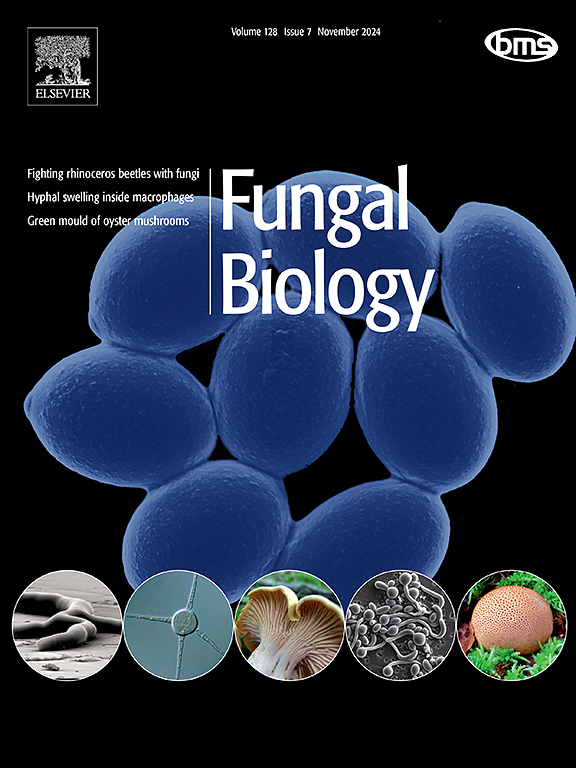Protein content and amino acid profile of wild mushrooms depend on environmental conditions
IF 3
3区 生物学
Q2 MYCOLOGY
引用次数: 0
Abstract
Wild mushrooms can be an important source of protein and essential amino acids, however very little is known about the environmental factors affecting the content of these compounds. In our study, we investigated the influence of soil properties (soil type, C/N ratio, pH) and tree stand characteristics (tree diversity, canopy cover, understory cover, and the proportion of deciduous trees) on total protein and essential amino acids (Valine, Leucine, Isoleucine, Phenylalanine, Lysine, Methionine, Arginine, Histidine) contents in seven wild-growing mushroom species (Macrolepiota procera, Rhodocolybia butyracea, Russula cyanoxantha, R.heterophylla, Lactifluus vellereus, Armillaria mellea s.l., and Xerocomellus chrysenteron). Our study showed that the identity of mushroom species determines, to a large extent, the protein content and the amino acid profile of the mushrooms. The highest protein content was revealed in X. chrysenteron, M. procera and R. butyracea. Effects of environmental factors were weaker and species specific. The protein content in X. chrysenteron was mainly influenced by soil type (Cambisols vs. Luvisols) and soil characteristics (positively by C/N ratio and negatively by soil pH). In L. vellereus the protein content was negatively influenced by stand characteristics (canopy cover, understory cover, and tree diversity). In M. procera the protein content decreased with decreasing understory cover, while for all the other studied species, the effects of environmental factors were negligible. Similarly, the amino acid profiles were not affected by any environmental factors, however, they seem to be consistent with ecological roles of the species (ectomycorrhizal, saprotrophic, parasitic fungi). This last result requires further investigation.
野生蘑菇的蛋白质含量和氨基酸分布受环境条件的影响
野生蘑菇可能是蛋白质和必需氨基酸的重要来源,但对影响这些化合物含量的环境因素知之甚少。在本研究中,我们研究了土壤性质(土壤类型、碳氮比、pH)和林分特征(树木多样性、冠层盖度、林下盖度和落叶树比例)对7种野生蘑菇(Macrolepiota procera、Rhodocolybia butyracea、Russula cyanoxantha、r.t heterophylla、Lactifluus vellereus、Lactifluus)总蛋白和必需氨基酸(缬氨酸、亮氨酸、异亮氨酸、苯丙氨酸、赖氨酸、蛋氨酸、精氨酸、组氨酸)含量的影响。蜜环菌(millillaria mellea s.l)和chryssenteron)。我们的研究表明,菌种的特性在很大程度上决定了菌种的蛋白质含量和氨基酸分布。蛋白质含量最高的品种为黄花蓟马、黄花蓟马和丁酸蓟马。环境因子的影响较弱,且具有物种特异性。黄菊花蛋白质含量主要受土壤类型(cambisol vs luvisol)和土壤特征(C /N比值正、pH负)的影响。林分特征(林冠盖度、林下盖度和树木多样性)对羊草蛋白质含量有负向影响。蛋白质含量随林下盖度的减少而降低,而环境因子对其他物种的影响可以忽略不计。同样,氨基酸谱不受任何环境因素的影响,但它们似乎与物种(外生菌根,腐养,寄生真菌)的生态作用一致。最后的结果需要进一步调查。
本文章由计算机程序翻译,如有差异,请以英文原文为准。
求助全文
约1分钟内获得全文
求助全文
来源期刊

Fungal biology
MYCOLOGY-
CiteScore
5.80
自引率
4.00%
发文量
80
审稿时长
49 days
期刊介绍:
Fungal Biology publishes original contributions in all fields of basic and applied research involving fungi and fungus-like organisms (including oomycetes and slime moulds). Areas of investigation include biodeterioration, biotechnology, cell and developmental biology, ecology, evolution, genetics, geomycology, medical mycology, mutualistic interactions (including lichens and mycorrhizas), physiology, plant pathology, secondary metabolites, and taxonomy and systematics. Submissions on experimental methods are also welcomed. Priority is given to contributions likely to be of interest to a wide international audience.
 求助内容:
求助内容: 应助结果提醒方式:
应助结果提醒方式:


